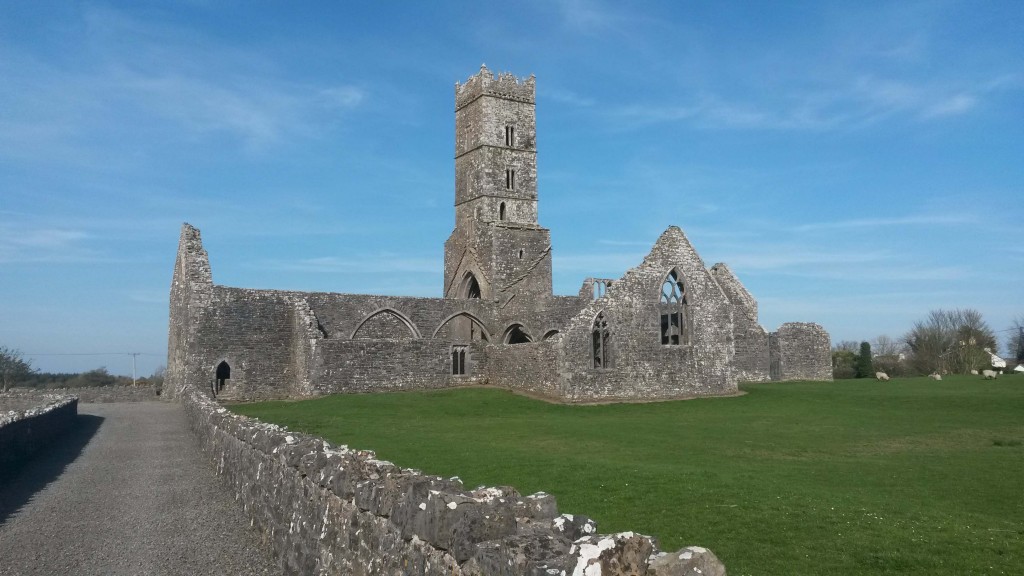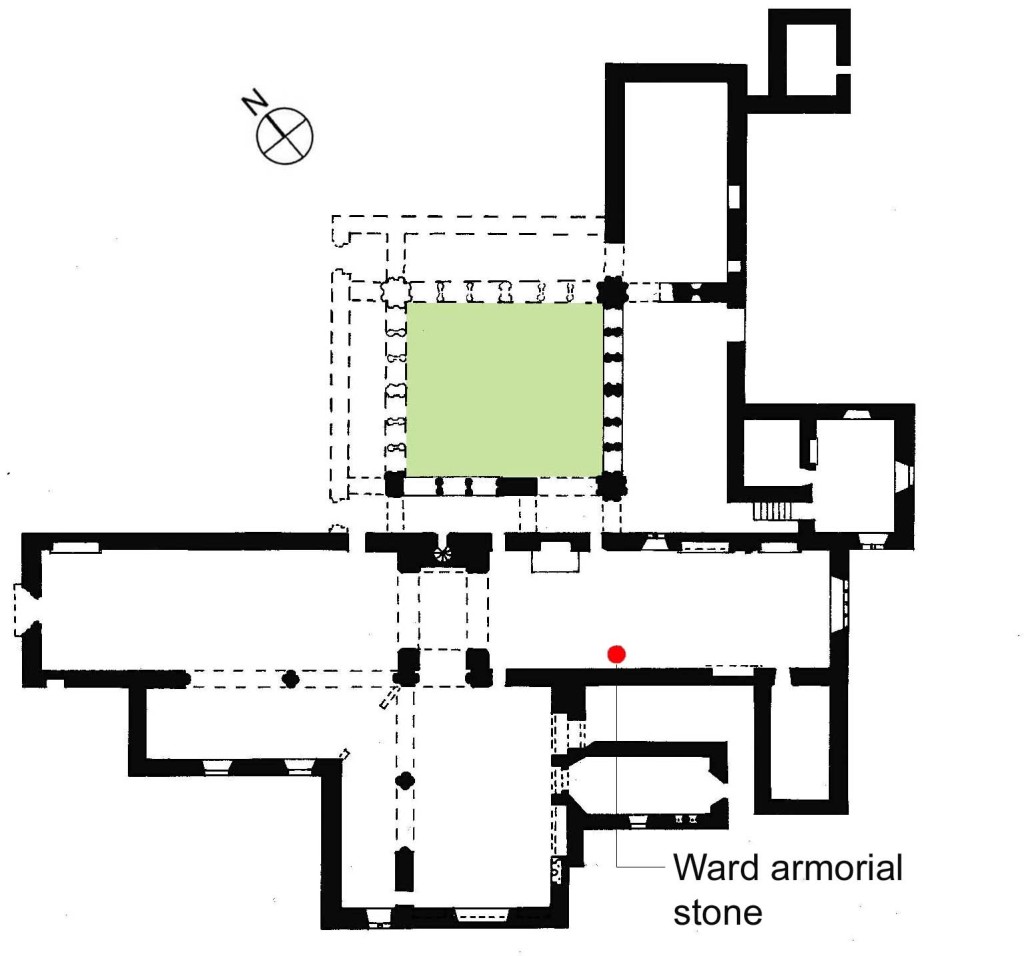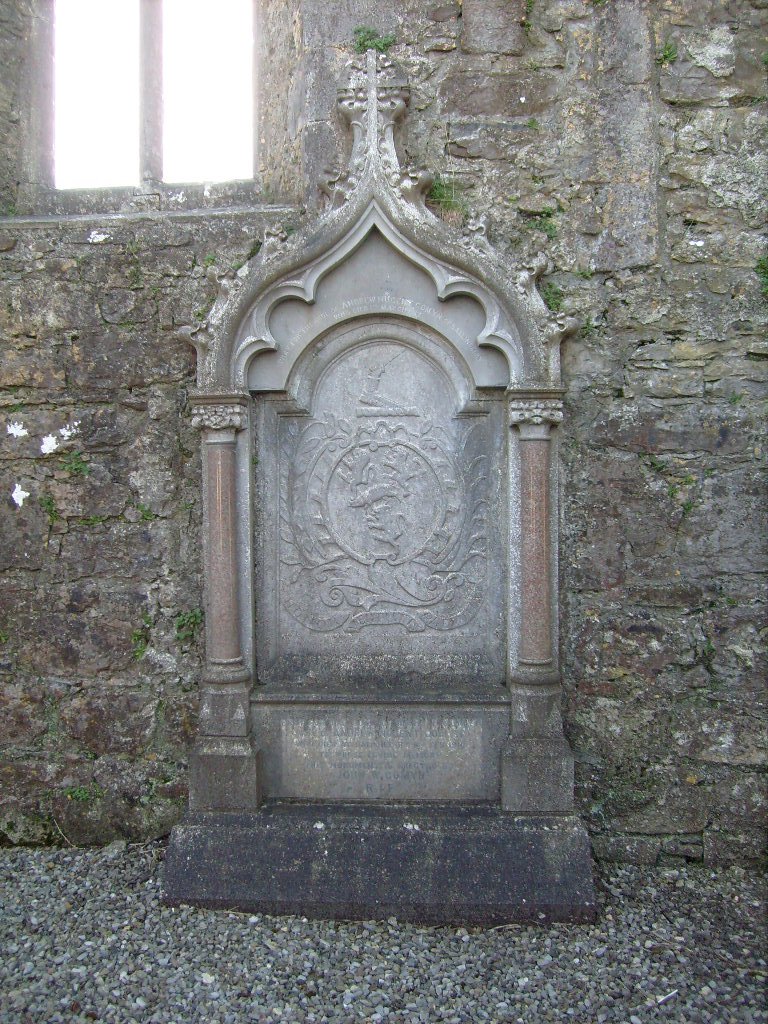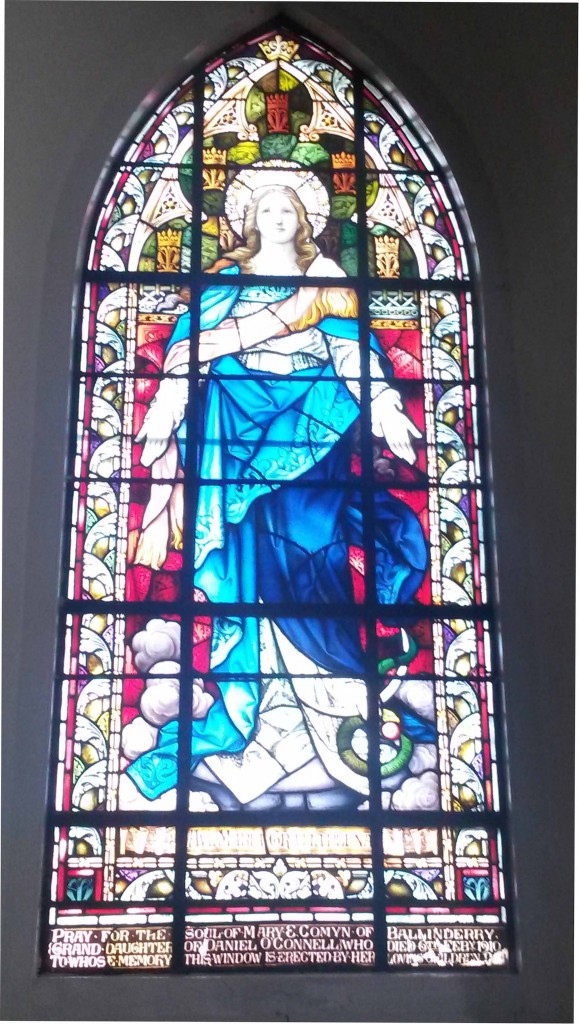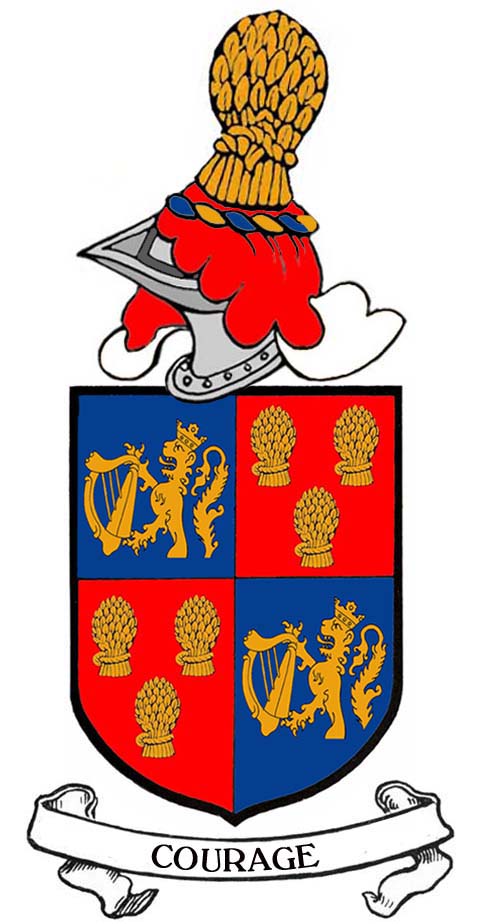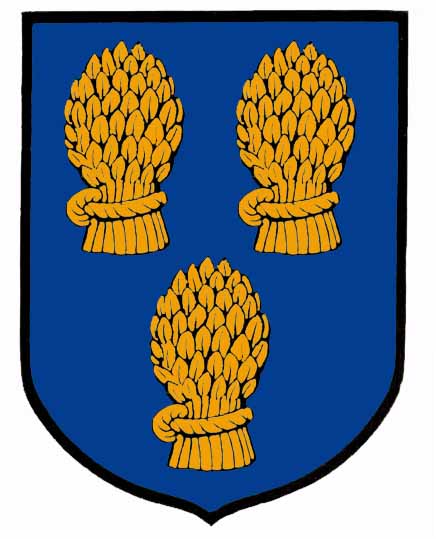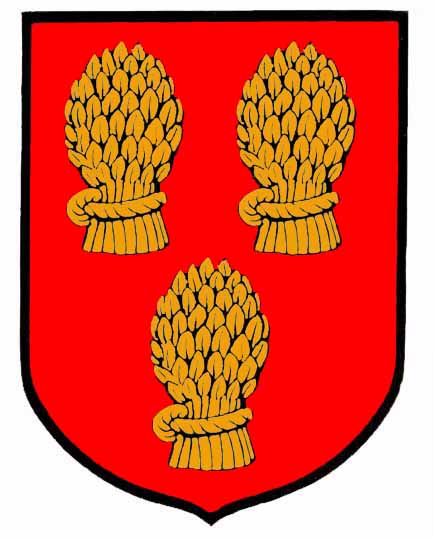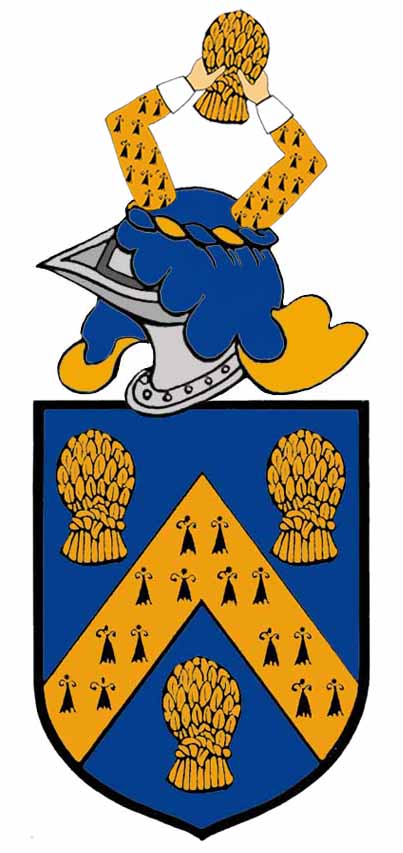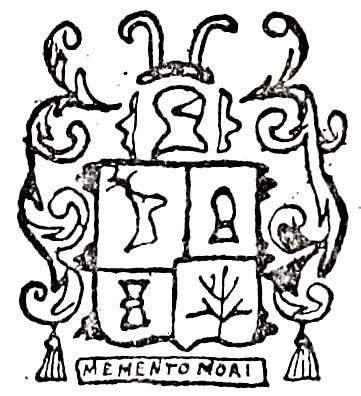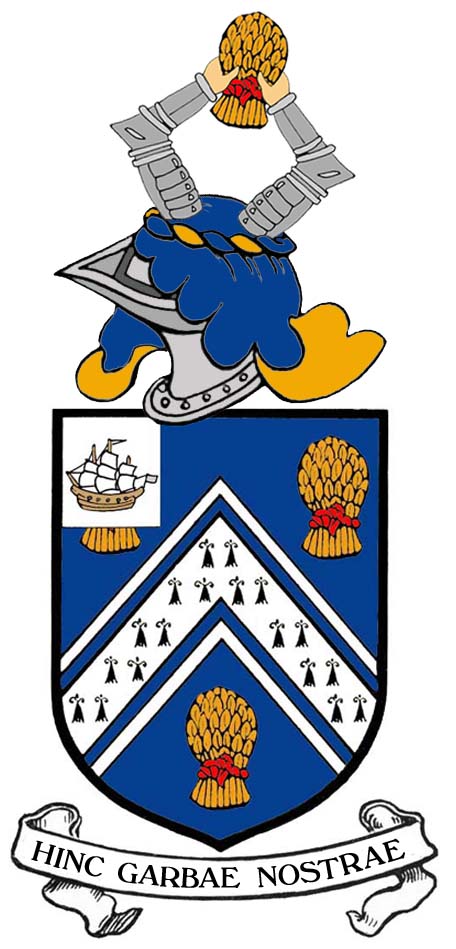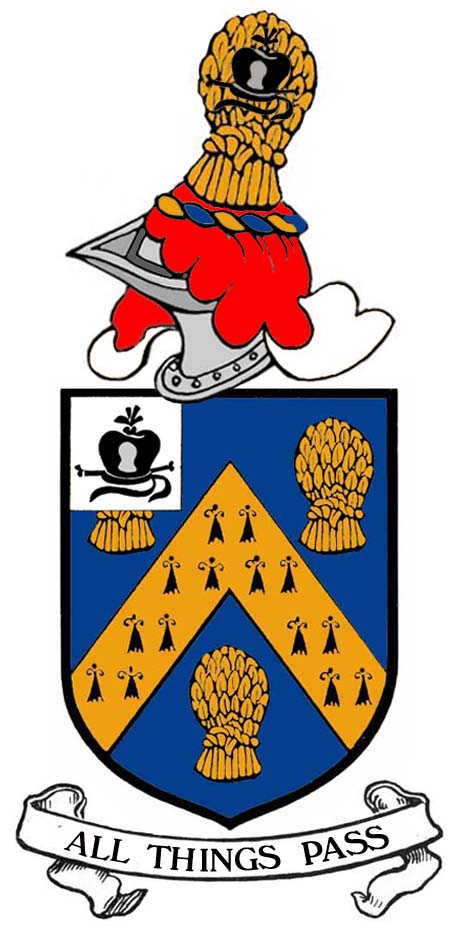© Donal G. Burke 2015
Andrew Comyn of Ryefield, Elphin, in the barony of Frenchpark, County Roscommon married Sabina Ward, sister and heiress of Lewis Ward of Ballymacward and Ballinderry House, Kilconnell in County Galway in 1786 and through this marriage the Comyn family came to be established in the east of County Galway in the late eighteenth century and early nineteenth century.[i]
The origin of this Comyn family (also given in sources as Cummins) is uncertain but it would appear that they were settled at Ryefield since at least from the mid seventeenth century. Research was undertaken into the origins of the Comyn family by Sir Alfred Scott-Gatty, Garter Principal King of Arms from 1904 to 1918 and Don Juan Manuel Comyn, Conde d’Abbiz which noted the death on the 4th January 1713 of one Andrew Comyn of Ryefield, and his burial at St. Mary’s Churchyard, Elphin.[ii] The genealogical line of the family is broken in the eighteenth century but it is believed that this Andrew’s son or grandson married Eleanor, daughter of Captain Thomas Browne of Hospital, one of whose children is believed may have been that Andrew Comyn of Ryefield who married Sabina Ward.[iii]
The Wards were of ancient descent in the area about Ballymacward in east Galway and were tenants at Ballinderry House, Kilconnell, leasing the property from the Stanford family, who sub-let the lease from the Ecclesiastical Commissioners of the Church of Ireland. While the Wards continued at Ballinderry into the early nineteenth century, Andrew Comyn does not appear to have resided there. One J. Comyn was resident there in 1837 and on the disestablishment of the Church of Ireland Nicholas, son of Andrew Comyn and Sabina Ward acquired the freehold of the property.[iv]
Nicholas, son of Andrew and Sabina Coymn, was born in 1787, and while he is given as one among other issue of his parents, he would appear to have been the senior-most or senior-most surviving, given that he possessed both Ryefield and Ballinderry in his time, apparently simultaneously. In 1830 he married Sabina Joyes of Woodquay in Galway and had at least five children; two sons; Andrew Nugent Comyn, born in 1831 and John Ward Comyn. Their three daughters; Mary Ellen, Sabina and Elizabeth, all died young. Nicholas died in 1843 and was succeeded by his eldest son Andrew Nugent Comyn of Ballinderry and Ryefield.
Andrew Nugent Comyn appears to have been resident at Ballinderry in the middle of the nineteenth century, about the time of Griffith’s Valuation, while Ryefield at that time was leased to another. A Roman Catholic, he married in 1867, at the age of about thirty-six years, Mary, second daughter of John O Connell M.P. and grand-daughter of the celebrated Daniel O Connell who campaigned for Catholic Emancipation. By his wife he had three sons and three daughters; Nicholas O Connell, born in June 1869, Andrew Daniel, Lewis James, Elizabeth Mary, Geraldine Mary and Eily Mary.[v]
A. N. Comyn was active to a degree in local affairs and served as a member of a committee selected at a meeting in January 1880 of the Board of Guardians which sought assistance from the then Marlborough Fund to alleviate distress in the district of Ballinasloe caused by poor harvests and poor weather over the preceding years and an ensuing agricultural depression. (Other members of that Committee included Lords Clancarty, Ashtown and Clonbrock, J. O Shaughnessy J.P., E.W. Fowler J.P. and the Rev. Charles Lawrence of Belview.)[vi]
While Andrew Nugent appears to have retained ownership, his brother or another member of the family appears to have resided at Ballinderry in 1894, it being described in that year as the residence of Colonel John Comyn. Andrew Nugent Comyn, however, was recorded as resident at Ballinderry House in the 1901 Census of Ireland.
In early February 1910 Mary Comyn alias O Connell died. She was buried in the grounds of Kilconnell friary, where a commemorative armorial stone was later erected to her memory by her brother-in-law John Ward Comyn, which would suggest that it was erected several years after her death and that of her husband, who survived his wife by seven years. The monument incorporated an earlier armorial stone which appears to have been that of the Comyn’s predecessors, the Ward family, which would imply that the Comyns may have used the former burial place of the Wards. (An earlier recumbent slab to others of the Ward family lay nearby.)
The ruined church of Kilconnell friary, viewed from the South West.
Plan of Kilconnell friary church showing the location of the Ward armorial stone utilised to commemorate the death in 1910 of Mary, wife of Andrew Nugent Comyn.
The stone bearing the arms of Ward of Ballymacward at Kilconnell friary. The Ward family of Ballymacward and Ballinderry were representatives of a family of Sodhan origin in east Galway, who, with a small kin-group of others such as the O Mannions, Dugans and Scarrys, are held by tradition to have been established in that region prior to the arrival or rise of the O Kellys and the Uí Maine family group. The armorial stone would appear to have been incorporated in the Comyn monument by John Ward Comyn of Ballinderry who died in 1929 at the age of ninety-three years. In addition to Andrew Nugent Comyn and his wife and brother, other members commemorated later in an inscription at the base of the stone were Nicholas O Connell Comyn, his son Reginald and Mary Cecilia, wife of the former.
The stained glass window commemorating the death of Mary Comyn of Ballinderry, emphasising her descent as granddaughter of Daniel O Connell. The window was erected by her children in the Roman Catholic church at Kilconnell village, where the family occupied the front pews during their time at Ballinderry.[vii]
Andrew Nugent Comyn died in 1917 and was succeeded by his eldest son Nicholas O Connell Comyn of Ballinderry, County Galway. A Justice of the Peace, he served as High Sheriff of County Galway in the same year that his father died. In his younger years he had served with the Leicestershire Yeomanry in the South African War and thereafter with the Transvaal Mounted Police, retiring with the rank of Inspector in 1908.[viii] A year after his mother died he married Mary Cecilia Hyacinth, eldest daughter of Francis Walter Mahony, J.P., of St. Helen’s, Blarney, County Cork, by whom he had five sons and three daughters; Andrew Francis, born in 1913, Nugent Gerald Ward, Arthur, Reginald, Frederick, Marguerite, Maureen and Veronica. He died on 8th December 1945, pre-deceased by his son twenty-three year old son Reginald, who was killed on active service in the Royal Air Force in August of the previous year.
Nicholas’ principal heir was his eldest son Andrew, who, after an education at Clongowes and University College Dublin, pursued a career in law and practiced as a solicitor. He married Cherrie Deane, daughter of Joseph Hannay Lytle of The Point, Groomsport, County Down in 1945 by whom he had four sons and three daughters; Nicholas, born in 1946, Arthur, Hugh, Philip, Deirdre, Cherrie and Andrea.[ix]
The Comyn family remained at Ballinderry until 1947, when they sold the property to the Irish Land Commission. The senior line in the person of Andrew O Connell Comyn thereafter came to reside at Westwood, Mallow, County Cork.[x]
Confirmation of arms
The arms used by this particular Comyn family were only officially confirmed as theirs in 1959 when a representative of a junior branch of the family applied for a confirmation of arms from the office of the Chief Herald of Ireland in that year.
Given the infrequency of heraldic visitations in Ireland and the resultant paucity of complete records, Ulster King of Arms was given the power to grant certificates of confirmations of arms to those who could provide satisfactory proof that their ancestors in the male line had borne the same arms for at least three generations or before 1800. The facility was maintained by the Chief Herald, Ulster’s successor in the Republic of Ireland, who, on application by an individual, may confirm arms where the applicant can prove that the arms have been used by three generations or for at least one hundred years. In the case of the Comyns of Ballinderry the applicant was Major John Andrew Comyn of Springmount, Mallow, County Cork, eldest son of Colonel Lewis James Comyn of Spring Cottage, Milltown, County Cork and grandson of Andrew Nugent Comyn of Ballinderry, County Galway and Ryehill in County Roscommon, the latter described in the subsequent confirmation as ‘great-great grandson of Andrew Comyn of Ryefield.’[xi]
The applicant’s father Lewis James Comyn, born in 1878, was representative of the next senior line to those descendants of Nicholas O Connell Comyn of Ballinderry House and later of Westwood. While he was the third son of Andrew Nugent Comyn of Ballinderry House and Ryefield, his only paternal uncle, Andrew Daniel, had died unmarried in 1949 and a generation earlier his grandfather’s only brother John Ward Comyn had died unmarried in 1929.
Lewis James Comyn, married to Esther Egan, had a distinguished military career and served in the British Army in World War One. He was awarded the Distinguished Service Order in 1916, was invested as a Companion of the Order of St. Michael and St. George in 1918, awarded the Legion d’Honneur, was mentioned five times in despatches and attained the rank of Colonel of the Connaught Rangers. Following the First World War he served as an instructor at the Staff College at Camberley for three years, and in 1926 commanded the second Battalion of the King’s Own Scottish Borderers. Between 1929 and 1933 he served as Assistant Quartermaster-General of the Egyptian Command. From 1941 to 1945 he served as commander of the Wimborne Battalion of the Home Guard. He had two sons and a daughter; John Andrew, Victor Lewis and Mary Elizabeth, all three of whom served as officers in the British Army during World War Two. Colonel Lewis Comyn was about eighty-one years when his eldest son Major John Andrew Comyn applied for a confirmation of arms. He died two years later in March 1961.[xii]
The applicant Major John A. Comyn, born in 1915 and educated in England, was taken Prisoner of War in North Africa during the Second World War. He married firstly Diana Neal in 1948 and retired with the rank of Major in the King’s Royal Irish Hussars in 1950. After the war he was Director of Strutt & Parker (Farms) Ltd. and came to reside at The Old Rectory, Terling, near Chelmsford, Essex. Following a divorce he married secondly Elizabeth Grant in 1963. Five years later he was invested as a Member of the Order of the British Empire and was made a Fellow of the Chartered Institute of Secretaries. By his first wife he had three sons; John Archibald, Charles Lewis and David John and by his second another son; Trevor Alexander.[xiii]
The arms confirmed unto Major John Comyn of Springmount and his descendants was also widened to include all descendants of Andrew Comyn.[xiv] While two Andrew Comyns, both ancestors of the applicant, were mentioned in the grant, one was described as Andrew Nugent of Ballinderry and Ryefield and one as Andrew of Ryefield, who would appear to have been that Andrew who died in 1713. It would appear that it was this latter Andrew that the Chief Herald of Ireland had in mind to whose descendants the arms were confirmed.
The arms confirmed were emblazoned as ‘quarterly, first and fourth, Azure, a demi-lion crowned supporting a harp Or; second and third, Gules, three garbs Or, and for crest; a garb Or mantled Gules doubled Argent and for motto ‘courage.’[xv]
The arms confirmed in 1959 by Gerard Slevin, Chief Herald of Ireland, as those of Major John Andrew Comyn of Springmount, Mallow, County Cork, grandson of Andrew Nugent Comyn of Ballinderry, Kilconnell, County Galway and Ryehill in County Roscommon, the applicant’s descendants and the descendants of Andrew Comyn of Ryefield.
The garb as principal heraldic charge
A common charge or element found on the arms of many armigers of the name Comyn or Cummins is the garb or sheaf of grain. ‘Boutell’s Heraldry’ was of the view that ‘a garb should be treated as wheat unless some other grain is specified or clearly indicated.’[xvi] This charge was found on some of the earliest arms and was the principal charge on the arms of Comyn, Earl of Buchan in Scotland and the arms of the earls of Chester in England. Fox-Davies was of the opinion, however, that ‘though a garb, unless quoted otherwise, is presumed to be a sheaf of wheat, the term is not so confined.’ According to him, ‘the garbs in the arms of Comyn, which figure as a quartering in so many Scottish coats, are really of cumin, as presumably are the garbs in the arms of Cummins.’[xvii]
The foremost family of the name Comyn in the medieval period was that of Badenoch in Scotland, members of which held the earldom of Buchan and the lordship of Badenoch. The arms of the Earls of Buchan were given in certain sources as Azure, three garbs Or while they were given in Jenyns Ordinary as a shield Gules three garbs Or banded Gules. The line of the Comyn lords of Badenoch bore for arms Gules three garbs Or.
Arms of the Comyn Earls of Buchan
Arms of the Comyn Lords of Badenoch
Azure three garbs Or were also the arms of the earls of Chester in the medieval period and was associated with the earldom itself. (A roll of arms dated circa 1260 shows Azure three garbs Or as ‘Le Counte de Cestre.’) In addition to the principal family holding the title, garbs came to feature in the arms of a number of families associated with the earldom or who held lands by feudal tenure under the earls of Chester such as the Cholmondeleys.[xviii]
The arms of other individuals of the name were recorded in various medieval and late medieval Rolls of Arms, but no further information to definitively confirm their identity. One John Comyn was ascribed arms of Gules three garbs Or during the reign of Edward I while Sir John Comyn of Lincolnshire bore argent crusily and three garbs gules during the reign of Edward II. Another unidentified individual of the surname was given in a Rolls of Arms dating from the reign of King Henry III roll as bearing Azure semée of estoiles Or a chief Argent over all three garbs Argent (but probably counter-charged) banded Gules.
Garbs also featured prominently on most Late Medieval and Early Modern seals used by various Cumins or Comyns. Seals surviving of various members of the Buchan family, such as those used by Alexander Cumyn of Buchan circa 1292 and by John son of Alexander Earl of Buchan circa 1306 bore a shield of three garbs, two and one, with the latter displaying overall a label of three points. Another late thirteenth century seal was that of John Comyn of Kilbrick, Lord of Fakeham Magna in Suffolk, dated 1289, which carried a shield bearing ‘three garbs, two and one, suspended by a strap from the beak of crest, an eagle’s head erased.’ A variation thereon was used in the early fourteenth century seal of John Comyn of Ulseby in Lincolnshire, son of Sir John Comyn of Scotland, where he utilised a seal bearing a shield ‘on a bend between three garbs, as many water bougets,’ while the seal of John Comyn, Lord of Ulseby circa 1313 carried a shield of arms; three garbs between as many trefoils slipped. Another variation was that used by William Comyn, Lord of Kirkintolack, Dumbartonshire; ‘a shield of arms; semée of crosses crosslet, three garbs.’ Later surviving seals include that of Thomas Coming of Altyre in Rafford in Elginshire, Scotland, dating from 1476 and bearing a shield with ‘in chief two cushions, in base a garb, all within a tressure flory counter-flory, a crest on helmet and mantling of foliage of a talbot’s head. That of Alexander Cuming of Culter in Lanarkshire, dating from the early 1680s carried a shield ‘on a chevron between three garbs, a mullet for difference and above a helmet and mantling for crest a mullet. On a label in chief the motto ‘courage’ was inscribed.[xix]
Seal of John Comin, son of Alexander, Earl of Buchan, dated circa 1306, from Walter de Gray Birch’s ‘Catalogue of Seals in the Department of Manuscripts in the British Museum,’ Volume IV, 1895, Plate XI, No. 16,021.
The House of Badenoch in Scotland
The historian J. H. Round, writing in ‘The Ancestor’ in considering the history of the Scottish house of Comyn, earls of Buchan, was unclear as to their origin, other than that their connection with Scotland could be traced to the first half of the twelfth century when one William Cuimin served as Chancellor of Scotland. His nephew Richard Comyn married Hextilda, daughter of King Donald III and was granted lands in Northumberland by King David of Scotland and his son Henry. This Richard was ancestor of the Comyns of Badenoch.[xx]
The senior line of the Comyns attained the earldom of Buchan while the junior line held the lordship of Badenoch. When King Alexander III died in 1286 John Comyn, Lord of Badenoch, great great-grandson of Richard Comyn and Hextilda, who held a claim to the throne through his descent from King Donald III, was one of the six guardians appointed to govern Scotland in the regency of Margaret of Norway. The earl of Buchan and the lord of Badenoch were active in the struggle for Scottish independence from England in the early fourteenth century but John Comyn, lord of Badenoch was killed in 1306 by Robert Bruce, who rose to leadership among the Scots and acquired the kingship of Scotland. Both the Comyn titles of Buchan and Badenoch were declared forfeit. John Comyn’s son John fled to England and was killed fighting on the side of the English at the battle of Bannockburn in 1314 and two years later, his son Adomar, the last of senior male line of the lords of Badenoch died. After the extinction of the Comyn lords of Badenoch the chieftainship of the name resided in the line of Altyre in Scotland, the senior-most member of which branch in the late twentieth century was Sir William Gordon Gordon-Cumming of Altyre, 6th Baronet.
Irish Comyns and the House of Badenoch
A relationship may have existed between some of the earliest Anglo-Norman Comyns established in Ireland and the house of Badenoch in Scotland but it is uncertain. Of a possible, but unproven, connection between the Scottish Comyns and John Comyn, Archbishop of Dublin from 1182 to 1212, the first of name in Ireland, E. St. John Brooks, in an article on ‘the Early Irish Comyns’ published in the Journal of the Royal Society of Antiquities of Ireland in 1956, noted that when William, son of the Irish Justiciar Geoffrey de Marisco was accused of murder in 1235, others including a number of other de Mariscos and Comyns were involved. As the Justiciar was a nephew of the Archbishop, his father having married the Archbishop’s sister, it was considered likely that these Comyns and de Mariscos were kinsmen of the Archbishop. When the Justiciar was later exiled in 1242 he fled to Scotland, where he found refuge with Walter Comyn of Badenoch. The political relationship between the de Mariscos and the family of Badenoch was taken as a possible indication of a familial relationship between the two and therefore possibly, by extension, between the Comyns of Ireland and Scotland.[xxi]
As St. John Brooks noted, ‘there are certainly some indications that as far back as the early part of Henry III’s reign it was believed, or assumed, that the Irish Comyns (of Anglo-Norman extraction) were related to those of Scotland.’[xxii]
The demi-lion crowned supporting a harp
The demi-lion crowned and supporting a harp found in the first and fourth quarter of the Comyn of Ballinderry achievement also appear as the crest of a family named Comyn seated at Woodstock in County Galway and of Kilcorney in County Clare. In the case of Woodstock and Kilcorney the demi-lion was Gules crowned Or, supporting what was described as an Irish harp Proper. ‘Burke’s Landed Gentry of Great Britain and Ireland’ in the year 1802 noted that this family, ‘established in Ireland for many centuries,’ claimed descent as a junior line from ‘the great Scottish House of Comyn of Badenoch, in which vested the office of Justiciary of Scotland and on which was conferred the earldom of Buchan.’[xxiii] ‘At an early period after their settlement in Ireland, we find the Comyns resident at Comyn’s Castle in St. Mary’s Parish, Limerick, of which city a member of the family filled the chief civic office far back as the reign of Henry IV. From Limerick the Comyns passed into Clare and became possessed of a considerable landed property in that county.’ The same publication went on to state that ‘from Sir William Comyn, knight, of Limerick, living circa 1440, great grandson of Sir Laurence Comyn, knight, lineally descended the Comyns of Corcomroe, of whom a pedigree is registered in the office of the Ulster King of Arms in the year 1748 and (also) the Comyns of Kilcorney.’[xxiv] The arms given for this family, seated in 1802 at Woodstock and Kilcorney, comprised a shield ‘the same as Comyn of Badenoch; Gules three garbs Argent’ and a crest as described above.
While this family claimed descent from the family of Badenoch, the same claim was difficult to prove. E. St. John Brooks was of the view that the Limerick Comyns, who were claimed to have filled the offices of mayor and bailiff from sixty to seventy times, were ‘very probably’ descended from the Comyns of Tullamain in County Tipperary and that one of this Limerick family, one John Comyn, was transplanted in 1656 to Kilcorney in County Clare. He noted that the Coymns, an Anglo-Norman family, were established at Tullamain from the middle of the thirteenth century to the middle of the seventeenth century. These he included among ‘some of the Irish Comyns who were either certainly or presumably relatives of Archbishop John Comyn’, the first Anglo-Norman Archbishop of Dublin, who died in 1212.[xxv]
St. John Brooks gave one Gilbert Comyn, who was nephew of the Archbishop and from whom the former received a grant of property in County Wicklow between 1182 and 1212, as a probable ancestor of the Tullamain family. The same Gilbert, he noted, held land in Somerset in England from the Archbishop in 1200 and had a brother Peter who bequeathed to him all his lands in England and Ireland after his death.
In the opinion of St. John Brooks, ‘there is little reason to doubt that the ancestors of the various Irish families of Comyn or Cuimin in Ireland (excluding those of Gaelic origin) came to the country in the wake of John Comyn, the first Anglo-Norman Archbishop of Dublin.’ ‘No Comyns,’ he noted, ‘were known before his time.’[xxvi] The Tullamain family were one of a number of families of Anglo-Norman Comyns held by St. John Brooks to be related to the Archbishop, whom he believed the evidence proved to have been of Somerset origin, but with contemporary relatives of the same surname in Newbold Comyn in Warwickshire, Walcote in Wiltshire and Kinsaley in County Dublin.
Comyn armigers in early modern England
The arms of a number of Comyn armigers were recorded in the heraldic visitations undertaken by Officers of Arms across England in the late sixteenth and throughout the seventeenth century.
Among those armigers of the name Comyn in England, Francis Comyn of Whitby in Yorkshire was aged thirty-four years and the father of two daughters in August of 1665 when an heraldic visitation was held in that shire by Sir William Dugdale, Norroy King of Arms. The son of Tomothy Comyn of Durham and grandson of Symon Comyn of the City of Durham, his arms were given as ‘Azure, a chevron Erminois between three garbs Or. His crest comprised ‘two arms embowed, vested Erminois, cuffed Argent, the hands Proper holding a garb Or and was originally granted ‘unto the Armes anciently belonging to this family,’ by Richard St. George, then Norroy King of Arms, to Francis’ grandfather Symon in 1615.[xxvii]
Arms of Francis Comyn of Whitby as described in the 1665 Visitation of Yorkshire, showing the crest granted in 1615 to his grandfather Symon Comyn of Durham.
Another variation of this configuration occurs in a hatchment found at Chigwell in Essex commemorating the death in 1696 of Francis Comyns of White Hart, who married Anne, widow of one Edmund Denny. His funeral hatchment on an all black background and displayed the Comyns arms on the dexter half of the impaled shield as Sable a chevron ermine between three garbs Or, while that of his wife’s family were displayed on the sinister. His crest was shown as two arms embowed holding a garb Proper.[xxviii]
Various other armigers of the name in Ireland
A note was taken in the late nineteenth century of the armorial bearings used by a family of the name Cumin in the previous century who appear to have settled in the north of Ireland. Francis Joseph Bigger of Ardrie, Belfast informed the Journal for the Preservation of the Memorials of the Dead in 1891 that this family of Cumin was among a number who were of Scottish extraction, principally from the Lowlands, and whose arms were carved on tombstones in the graveyard at Carnmoney, County Antrim, adjoining the parish of Shankill, Belfast. He noted, however, that the family were not known in the parish of Carnmoney by the early 1890s and no trace of whom could be found ‘saving a few short records in the Session Book.’ Their arms, ‘well cut on the back of red sandstone,’ were dated 1742 and appear to have been obscure and difficult to decipher at that time. Bigger described them as ‘quarterly, first, a stag’s head couped facing to the sinister, second, what Bigger took to have possibly been a covered cup (but, alternatively, this may have been a garb), third, a garb, ‘fourth quarter enlarged, a charge like a five-branched candlestick and from each side of the shield issue three demi fleur-de-lis. Surmounting the shield an esquire’s helmet facing to the sinister with mantling.’[xxix] The crest Bigger described as two ram’s horns. Below the arms was carved the reminder ‘Memento Mori.’ Bigger believed it probable that these arms were reversed.
Sketch of the arms of a Cumin family of Scottish extraction, dated 1742, drawn by F. J. Bigger and provided to the Journal of the Preservation of the Memorials of the Dead, Ireland in 1891.
Edward MacLysaght, Chief Herald of Ireland, in his ‘Irish Families,’ makes it clear that, other than those who may be of Anglo-Norman, English or Scottish extraction, Cummins and variants thereof also appears as an anglicised form of the Gaelic surname Ó Coimín in Ireland.[xxx] It also appears, he states, as Ó Comáin in Munster, ‘whence come the majority of present day Cumminses (also called Commane) now found in Counties Tipperary and Cork.’ Another Gaelic family anglicised as Cummins, but of Ulster origin, he notes as MacCoimín.
It is worthy of note, however, that since the Gaelic Revival of the late nineteenth century and the establishment of the Free State in the early twentieth century, with the then emphasis on utilising the Irish translation or version of an individual’s surname on certain occasions or for certain purposes, it is not inconceivable that individual families of the name Cummins or Comyn in Ireland, of old Anglo-Norman origin, unaware of their ancestry may have adopted the Gaelic translation of their name on the assumption of Gaelic ancestry.
It was not uncommon that those bearing a similar name but of separate origin, for instance Gaelic or Anglo-Norman, were attributed arms by the heraldic authorities bearing a similar composition to those already armigerous of a similar name but distinct origin. In the case of Madden, those O Maddens of Native Irish extraction in east Galway bore arms similar to those Maddens of English extraction who settled about County Dublin about the end of the sixteenth or beginning of the seventeenth century and those named Madan who were settled about the town of Waterford in the late medieval period. (In that case, however, it was erroneously assumed for some time that all were of similar origin, being different branches descended of a common Gaelic progenitor.) Similarly, those of the name O Hannon in Ireland have been associated with arms similar to those of the Hanham family of England, the latter armigerous for some time before those of Native Irish extraction.[xxxi] In the case of those of the name Comyns or Cummins in Ireland, either of Gaelic or Anglo-Norman extraction, the garbs of the early Anglo-Norman armigers have been used as a principal charge. While the Comyns of Ballinderry bore the basic Gules three garbs Or as part of their arms, in at least two Irish examples of armigers of the name, a chevron appears between the three garbs and a canton in the dexter chief upon which appears a charge.
In 1899 Sir Arthur Vicars, Ulster King of Arms, confirmed arms on a prominent family of the name Cummins in County Cork who claimed to have borne the same arms for several generations but no record of which had been recorded prior to that date in Ulster’s office. Arms of ‘Azure, a chevron Ermine, cotised Argent, between three garbs or, banded Gules, on a canton of the third a ship in full sail Proper’ were confirmed on Henry Alfred Cummins, Esquire, Doctor of Medicine of the Royal University of Ireland and Major in Her Majesty’s Royal Army Medical Corps, second son of the deceased William Jackson Cummins of the City of Cork, Doctor of Medicine of the University of Edinburgh, son of Robert King Cummins of Belmont in County Cork, son of Nicholas Cummins of the same city, merchant.[xxxii] The arms, which included a crest of ‘two arms embowed vambraced, the hands Proper holding a garb as in the arms’ and motto of ‘Hinc Garbae Nostrae’ were confirmed unto Henry Alfred Cummins, his descendants and all the descendants of his great grandfather Nicholas Cummins.[xxxiii]
This family of Cummins descended from the second marriage of James John Cummin, Master of H.M.S. Chesterfield in 1759 and who died and was buried at sea in the following year.[xxxiv] The ship in full sail upon the canton in the family arms would appear to be a reference to this individual. His first son by his second marriage was Nicholas of Woodville, Glanmire, County Cork, born in 1754, who was mentioned in the confirmation of arms and who was thrice married. He had no children by his third marriage but by his first marriage he had a daughter Charlotte who married Thomas, nephew of Sir Henry Mannix, 1st Baronet of Richmond, Glanmire, County Cork and who died without issue. By his second marriage to Mary, daughter of Robert King of Hammond’s Marsh, Cork he had four sons and five daughters, the third son of whom was Robert King Cummins of Belmont, Cork, born in 1791. This latter individual married twice. By his first marriage to Mary, daughter of John Ashley of Ashley Hall in Jamaica he had one son named Nicholas of Ashley House and Myrtleville who served as High Sheriff of Cork in 1838. By his second marriage to Mary, daughter of William Jackson of Bitton, Teignmouth in Devon he had three more sons and a daughter, the eldest of whom by this marriage was William Jackson Comyn MD, born in 1824. This Dr. William Jackson married thrice and died in 1893. By his first marriage he had one son and four daughters, by his second one son and by his third marriage four sons and two daughters. The applicant for the confirmation was arms was his second son Henry Alfred, the eldest son of his second marriage to Elizabeth Poole of Mayfield, Bandon, County Cork.[xxxv]
Henry Alfred Cummins, like his father, pursued a medical career. He was born in 1864 and served as an officer in the RAMC, serving in the Sikkim Expedition in 1885, the Ashanti Expedition of 1895-1896 and from 1899 and 1901 served in the South African War.[xxxvi] He was invested as a Companion of the Order of St. Michael and St. George in the year following the confirmation of arms. In 1932 he was Emeritus Professor of Botany at University College Cork. He married Ethel, daughter of Robert Constable Hall, J.P., of Rockcliffe, Blackrock, Cork, by whom he had one son and four daughters and died in 1938. He was of a junior branch in line of descent from his great-grandfather Nicholas Cummins of Woodville in Glanmire, County Cork and as the confirmation of arms was extended to include all descendants of that same Nicholas, the senior-most line of those armigers was that descended from Nicholas’ eldest son by his second marriage; Nicholas Marshall Cummins J.P., of Annemount, Glounthaune, County Cork, who was born in 1808, married twice and died in 1885.[xxxvii]
The arms confirmed by the Ulster King of Arms in 1899 as those of Major Henry Cummins R.A.M.C., his descendants and the other descendants of his great grandfather Nicholas Cummins of Cork City, after those depicted in N.L.I. Dublin, G.O. Ms. 111, Grants and Confirmations of Arms, Vol. J, 1898-1909, folio 39.
The arms of Micheál Ó Comáin, Herald of Arms at the Office of the Chief Herald of Ireland, sometime resident of Craughwell, Co Galway. Members of this family have rendered the name variously as Comyns, Cummins and Ó Comáin.
[i] Montgomery-Massingbred, H. (ed.), Burke’s Irish Family Records, Burkes Peerage Ltd., London, 1976, pp. 264-5.
[ii] Montgomery-Massingbred, H. (ed.), Burke’s Irish Family Records, Burkes Peerage Ltd., London, 1976, pp. 264-5.
[iii] Montgomery-Massingbred, H. (ed.), Burke’s Irish Family Records, Burkes Peerage Ltd., London, 1976, pp. 264-5.
[iv] Lewis, Topographical Dictionary of Ireland, 1837.
[v] Montgomery-Massingbred, H. (ed.), Burke’s Irish Family Records, Burkes Peerage Ltd., London, 1976, pp. 264-5.
[vi] Rev. P. K. Egan, The Parish of Ballinasloe, Its history from the earliest times to the present century, Dublin 1960, p. 276.
[vii] Nolan, L., The Past Recalled, Scannell, J and Cooke, C. (eds.), The Social History of Aughrim since 1691, Aughrim Development Co. Ltd., 2004, pp. 158-163.
[viii] Montgomery-Massingbred, H. (ed.), Burke’s Irish Family Records, Burkes Peerage Ltd., London, 1976, pp. 264-5.
[ix] Montgomery-Massingbred, H. (ed.), Burke’s Irish Family Records, Burkes Peerage Ltd., London, 1976, pp. 264-5.
[x] Montgomery-Massingbred, H. (ed.), Burke’s Irish Family Records, Burkes Peerage Ltd., London, 1976, pp. 264-5.
[xi] NLI Dublin, G.O. Ms. 111I Grants and Confirmations of Arms, Vol. 18 S, fol. 11, dated 12 September 1959.
[xii] Montgomery-Massingbred, H. (ed.), Burke’s Irish Family Records, Burkes Peerage Ltd., London, 1976, pp. 264-5.
[xiii] Montgomery-Massingbred, H. (ed.), Burke’s Irish Family Records, Burkes Peerage Ltd., London, 1976, pp. 264-5.
[xiv] NLI Dublin, G.O. Ms. 111I Grants and Confirmations of Arms, Vol. 18 S, fol. 11, dated 12 September 1959.
[xv] NLI Dublin, G.O. Ms. 111I Grants and Confirmations of Arms, Vol. 18 S, fol. 11, dated 12 September 1959.
[xvi] Scott-Giles, C.W., Boutell’s Heraldry, Frederick Warne & Co. Ltd., London, 1950, p. 85.
[xvii] Fox-Davies, A.C., Complete Guide to Heraldry, Thomas Nelson and Sons Ltd., London, 1950, p. 280.
[xviii] Scott-Giles, C.W., Boutell’s Heraldry, Frederick Warne & Co. Ltd., London, 1950, p. 86; Fox-Davies, A.C., Complete Guide to Heraldry, Thomas Nelson and Sons Ltd., London, 1950, p. 280.
[xix] Forster, J., Feudal Coats of Arms, Senate , London, 1995, p. 59; de G. Birch, W., Catalogue of Seals in the Department of Manuscripts in the British Museum, Vol. II, Longmans and Co., London, 1892, pp. 681-2; de G. Birch, W., Catalogue of Seals in the Department of Manuscripts in the British Museum, Vol. IV, Longmans and Co., London, 1895, pp. 338-340; Laing, H., Supplemental Descriptive Catalogue of Ancient Scottish Seals, Edmonston & Douglas, Edinburgh, 1866, p. 44.
[xx] St. John Brooks, E., The Early Irish Comyns, J.R.S.A.I., Vol. LXXXVI, Part II, 1956, pp. 170-186.
[xxi] St. John Brooks, E., The Early Irish Comyns, J.R.S.A.I., Vol. LXXXVI, Part II, 1956, pp. 170-186.
[xxii] St. John Brooks, E., The Early Irish Comyns, J.R.S.A.I., Vol. LXXXVI, Part II, 1956, pp. 170-186.
[xxiii] Burke’s Landed Gentry of Great Britain and Ireland, Harrison, London, 1802, pp. 277-278.
[xxiv] Burke’s Landed Gentry of Great Britain and Ireland, Harrison, London, 1802, pp. 277-278.
[xxv] St. John Brooks, E., The Early Irish Comyns, J.R.S.A.I., Vol. LXXXVI, Part II, 1956, pp. 170-186.
[xxvi] St. John Brooks, E., The Early Irish Comyns, J.R.S.A.I., Vol. LXXXVI, Part II, 1956, pp. 170-186.
[xxvii] Dugdale, W., The Visitation of the County of York, begun in 1665 and finished in 1666, The Publications of the Surtees Society, Vol. XXXVI, George Andrews, Durham, 1859, p. 72.
[xxviii] Summers, P., Titterton, J.(eds.), Hatchments in Britain, Vol. 6, Cambridgeshire, Essex, Hertfordshire, Huntingdonshire and Middlesex, Phillimore & Co. Ltd., London and Chichester, 1985, p. 38. Essex by Christopher Harrold.
[xxix] Vigors, Col. P. D. (ed.), Report for the year 1891, Report for the year 1891 for the Fund for the Preservation of the Memorials of the Dead, Ireland, Dublin, 1893, p. 286-7.
[xxx] MacLysaght, E., Irish Families, their names, Arms and Origins, 4th Edition, Irish Academic press, Dublin, 1985, pp. 66-67.
[xxxi] Ó Comáin, M., The Poolbeg Book of Irish Heraldry, Poolbeg Press Ltd., Dublin, 1991, p. 156.
[xxxii] NLI Dublin, G.O. Ms. 111 Grants and Confirmations of Arms, Vol. J, 1898-1909, fol. 39.
[xxxiii] NLI Dublin, G.O. Ms. 111 Grants and Confirmations of Arms, Vol. J, 1898-1909, fol. 39.
[xxxiv] Montgomery-Massingbred, H. (ed.), Burke’s Irish Family Records, Burkes Peerage Ltd., London, 1976, pp. 306-309.
[xxxv] Montgomery-Massingbred, H. (ed.), Burke’s Irish Family Records, Burkes Peerage Ltd., London, 1976, pp. 306-309.
[xxxvi] Montgomery-Massingbred, H. (ed.), Burke’s Irish Family Records, Burkes Peerage Ltd., London, 1976, pp. 306-309.
[xxxvii] Montgomery-Massingbred, H. (ed.), Burke’s Irish Family Records, Burkes Peerage Ltd., London, 1976, pp. 306-309.


